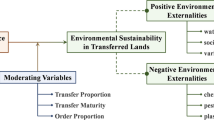Abstract
From the perspective of IT process and the theory of IT absorptive capacity, this paper mainly verifies the positive impact of different stages of e-commerce absorptive of agricultural products on the income-increasing effect. This paper introduces IT absorptive theory, tentatively puts forward the concept of e-commerce absorptive of agricultural products, divides the process of new agricultural business entities’ adoption of e-commerce of agricultural products into three dimensions of low, middle and high levels according to three functional dimensions that information publication, online purchase and whole process integration, and makes an empirical analysis of the relationship between the absorption degree of adoption of e-commerce of agricultural products of new agricultural business entities and income-increasing effect. It verifies that the degree of e-commerce absorptive of agricultural products has a positive effect on income-increasing effect and also clarifies the intensity of the role of resource allocation at various stages in income-increasing effect.

Similar content being viewed by others
Data availability
The datasets used and/or analyzed during the current study are available from the corresponding author on reasonable request.
References
Mueller, R. A. (2001). E-commerce and entrepreneurship in agricultural markets. American Journal of Agricultural Economics, 83(05), 1243–1249.
Xue, Y., Ma, B., & Peng, C. (2020). New type of agricultural management main body and the electronic commerce: Business mode selection and revenue performance. Journal of Agriculture and Forestry Economic Management, 12(4), 399–408.
Poole, B. (2001). How will agricultural e-markets evolve? Washington DC: paper presented at the USDA Outlook Forum.
Wang, Y. (2019). Electricity in increasing farmer economy gaining feeling? The difference between Poor and the Poor. China’s Rural Economy, 7, 37–50.
Liang, H., Saraf, N., Hu, Q., et al. (2007). Assimilation of enterprise systems: The effect of institutional pressures and the mediating role of top management. MIS Quarterly, 31(01), 59–87.
Nevo, S., & Wade, M. R. (2010). The formation and value of it-enabled resources: Antecedents and consequences. MIS Quarterly, 34(01), 163–183.
Adler, J. H. (1965). Absorptive capacity: The concepts and its determinants. Brooking Institutions.
Cohen, W. M., & Levinthal, D. A. (1990). Absorptive capacity: A new perspective on learning and innovation. Administrative Science Quarterly, 35(01), 128–152.
Zahra, S. A., & George, G. (2002). Absorptive capacity: A review, reconceptualization, and extension. The Academy of Management Review, 27(02), 185–203.
Makhloufi, L., Laghouag, A. A., Sahli, A. A., et al. (2021). Impact of entrepreneurial orientation on innovation capability: The mediating role of absorptive capability and organizational learning capabilities. Sustainability, 13(10), 1–20.
Purvis, R. L., Sambamurthy, V., & Zmud, R. W. (2001). The assimilation of knowledge platforms in organizations: An empirical investigation. Organization Science, 12(02), 117–135.
Sodero, A. C., Rabinovich, E., & Sinha, R. K. (2013). Drivers and outcomes of open-standard interorganizational information systems assimilation in high-technology supply chains. Journal of Operations Management, 31(06), 330–344.
Saga, V. L., Zmud, R. W. (1994). The nature and determinants of IT acceptance, routinization, and infusion. In Proceedings of the proceedings of the IFIP TC8 working conference on diffusion. Transfer and Implementation of Information Technology, Pittsburgh, PA, North-Holland: F.
Neirotti, P., & Paolucci, E. (2011). Assessing the importance of industry in the adoption and assimilation of IT: Evidence from Italian enterprises. Information and Management, 48(7), 249–259.
Martins, R., Oliveira, T., & Thomas, M. A. (2016). An empirical analysis to assess the determinants of SaaS diffusion in firms. Computers in Human Behavior, 62, 19–33.
Acknowledgements
This paper is supported by the Hubei Province University Philosophy and Social Science Research Project (21G133), and Wuhan Donghu University Scientific Research Team Project: Economic Policy Performance Evaluation Scientific Research Team (2021dhtd03), and Hubei Province Department of Education of Scientific Research Project (B2021561).
Author information
Authors and Affiliations
Corresponding author
Ethics declarations
Conflict of interest
No conflict of interest exits in the submission of this manuscript.
Additional information
Publisher's Note
Springer Nature remains neutral with regard to jurisdictional claims in published maps and institutional affiliations.
Rights and permissions
About this article
Cite this article
Lyu, D., Zhou, L. & Ma, X. Income-increasing effect of e-commerce of agricultural products based on IT absorptive theory. Wireless Netw 28, 2337–2344 (2022). https://doi.org/10.1007/s11276-022-02904-2
Published:
Issue Date:
DOI: https://doi.org/10.1007/s11276-022-02904-2




